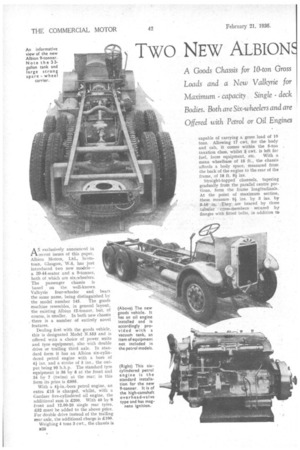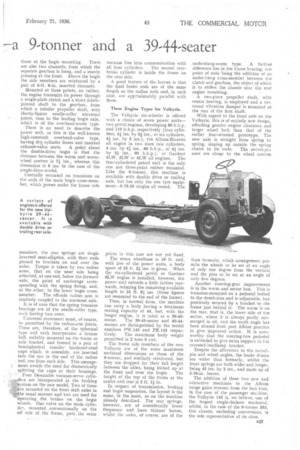Two NEW ALBION 9-tonner and a 39-44-seater A Goods Chassis
Page 40

Page 41

If you've noticed an error in this article please click here to report it so we can fix it.
for 10-ton Gross Loads and a New Valkyrie for Maximum capacity Single deck Bodies. Both are Six-wheelers and are Offered with Petrol or Oil Engines AS exclusively announced in recent issues of this paper, Albion Motors, Ltd., Scotstoun, Glasgow, W.4, has just introduced two new models— a 39-44-seater and a 9-tonner, both of ,which are six-wheelers. The passenger chassis is based on the well-known Valkyrie four-wheeler and bears the same name, being distinguished by
the model number 145. The goods machine resembles, in general layout, the existing Albion 12-tonner, but, of course, is smaller. In both new chassis there is a number of entirely novel features.
Dealing first with the goods vehicle, this is designated Model N.553 and is offered with a choice of power units and tyre equipment, also with double drive or trailing third axle. In standard farm it has an Albion six-cylindered petrol engine with a bore of 41 ins, and a stroke of 5 ins., the output being 95 b.h.p. The standard tyre equipment is 36 by 8 at the front and 34 by 7 (twins) at the rear; in this form its price is £995.
With a 44-in.-bore petrol engine, an extra 115 is charged, whilst, with a Gardner five-cylindered oil engine, the additional sum is £200. With 40 by 8 front and 12.00-20 single rear tyres, £52 must be added to the above price. For double drive instead of the trailing rear axle, the additional charge is £100.
Weighing 4 tons 3 cwt., the chassis is 826
capable of carrying a gross load of 10 tons. Allowing 17 cwt. for the body and cab, it comes within the 5-ton taxation class, whilst 3 cwt is left for
fuel, loose equipment, etc. With a mean wheelbase of 15 ft., the chassis affords a body space, measured from the back of the engine to the Tear of the frame, of 18 ft. 84 ins.
Straight-topped channels, tapering gradually from the parallel centre portions, form the frame longitudinals. At the point of maximum section, these measure 94 ins. by 3 ins, by 516 in. They are braced by three tubular cross-members secured by flanges with fitted bolts, in addition to those at the bogie mounting. There are also two channels, from which the separate gearbox is hung, and a sturdy pressing at the front. Above the bogie the side members are reinforced by a pair of 5-ft. 6-in, inserted channels.
Mounted at three points, on rubber, the engine transmits its power through a single-plate clutch and a short fabricjointed shaft to the gearbox, from which a tubular propeller shaft, with Hardy-Spicer needle-roller universal joints, runs to the leading bogie axle, which is of the overhead-worm type.
There is no need to describe the power unit, as this is the well-known high-camshaft overhead-valve type, having dry. cylinder liners and inserted exhaust-valve seats. A point about the double-drive bogie is that the distance between the worm and wormwheel centres is 71 ins., whereas this dimension is 8 ins, in the case of the single-drive model.
Centrally mounted on trunnions on the ends of the main bogie cross-member, which passes under the frame side members, the rear springs are single inverted semi-ellipties, with their ends pinned to brackets on and over the axles. Torque is taken by two radius arms, that on the near side being attached, at one end, below the forward axle, the point of anchorage corresponding with the spring fixing, and, at the other, to the lower bogie crossmember. The off-side radius arm is similarly coupled to the rearmost axle.
It is of note that the spring trunnion bearings are of the needle-roller type, each having two rows.
Universal movement must, of course, be permitted by the radius-arm joints.
These are, therefore, of the spherical type and each incorporates a bronze ball, suitably mounted on the frame or axle bracket, and housed in a pair of hemispherical annular hardened-steel cups which, in assembly, are inserted into the eye in the end of the radius rod, one from each sick. This a/rangement avoids the need for diametrically splitting the cups or their housings.
Four Dewandre vacuum-servo cylinders are incorporated in the braking yStem on the new model. Two of these re mounted on the front stub axles in he usual manner and two are used for 'operating -the brakes on the bogie wheels. One Valve on the main cylinder, mounted conventionally on the off side of the frame; puts the main
vacuum line into communication with
all four cylinders. The second rearbrake cylinder is inside the frame on the near side.
A good feature of the layout is that the final brake rods are of the same length as the radius rods and, in each case, are approximately parallel with them.
Three Engine Types for Valkyrie.
The Valkyrie six-wheeler is offered with a choice of seven power units— two petrol engines, developing 80 b.h.p. and 110 b.h.p. respectively (four cylinders, 4# ins. by 51 ins., or six cylinders, 41 ins. by 5 ins.), the Albion-Ricardo oil engine in two sizes (six cylinders, 4 ins. by 4I ins., 80 b.h.p., or 41 ins. by 51 ins., 90 b.h.p.), or Gardner 4I,W, 5LW or 6LW oil engines. The four-cylindered petrol unit is the only one not three-point Tubber mounted. Like the 9-toniaer, this machine is available with double drive or trailing axle, but has onlythe one tyre equipment-9.75-20 singles all round. The prices in this, case are not yet fixed.
The mean wheelbase is 19 ft. and, with five of the power units, a body space of 25 ft. 21 ins, is given. When the six-cylindered petrol or Gardner 6LW engine is installed, however, the power unit extends a little farther rearwards, reducing the remaining available length to 24 ft. 81 ins. (these figures are measured to the end of the frame).
Thus, in normal form, the machine can carry a body having a maximum seating capacity of 44, but, with the longer engine, it is rated as a 39-40
seater. The 39-40-seater and 40-44seaters are distinguished by the model numbers PW.145 and PR.145 respectively. The maximum body weight permitted is 2 tons 9 cwt.
The frame side members of the new Valkyrie are of the same maximum sectional dimensions as those of the 9-tonner, and similarly reinforced, but they are dropped for their full length between the axles, being kicked up at the front and over the bogie. The height of the top of the frame at the centre and rear is 2 ft. 14 in.
In respect of transmission, braking and bogie suspension, the layout is the same, in the main, as on the machine already described. .The rear springs, however, are of considerably lower frequency and have thinner leaves, whilst the axles, of course, are of the ,underslung-worm type. A further difference lies in the frame bracing, one point of note being the addition of an under-hung cross-member between the clutch and gearbox, the object of which is to stiffen the chassis near the rear engine mounting.
A two-piece propeller shaft, with centre bearing, is employed and a torsional vibration damper is mounted at the rear of the first shaft.
With regard to the front axle on the Valkyrie, this is of entirely new design, affording greater ,engine clearance and larger wheel lock than that of the earlier four-wheeled • prototype. The new axle is straight from spring to spring, sloping up outside the spring chairs to its ends, The swivel-pin axes are closar to the wheel centres than formerly, which arrangement permits the wheels to be set at an angle of only one degree from the vertical and the pins to be set at an angle of only five degrees.
Another steering-gear improvement is in the worm and sector box. This is trunnion-mounted on a pedestal bolted to the dumb-iron and is adjustable, but positively secured by a bracket to the frame just behind it. The worm is on the rear, that is, the lower side of the sector, where it is always partly submerged in oil, and the tooth angle has been altered from past Albion practice to give improved action. It is note-. worthy that the steering-box pedestal is extended to give extra support tO the recessed-headlamp bracket.
Despite the alteration to the swivelpin and wheel angles, the brake drums are wider than formerly, whilst the front springs are both wider and longer, being 45 ins. by 3 ins., and made up of 5-16-in. leaves. The addition of these two new and attractive machines to the Albion range gains interest from the fact that, in the case of the passenger machine, the Valkyrie 145 is, we believe, one of the largest single-deckers marketed, whilst, in the case of the 9-tonner 553, this chassis, excluding conversions, is -the sole representative of its class.




























































































